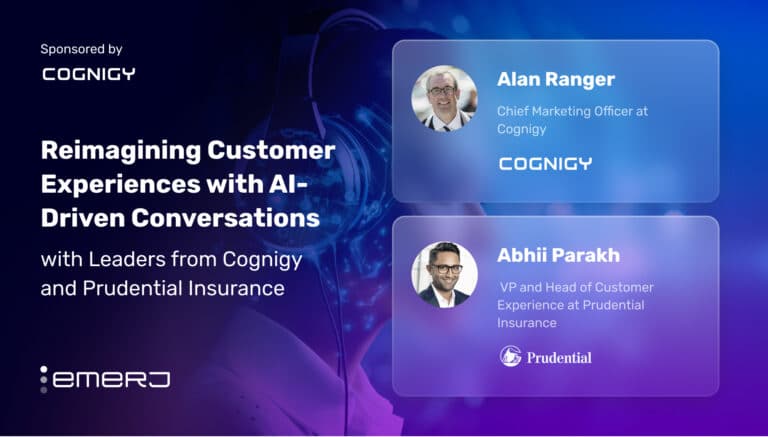This interview analysis is sponsored by Interactions and was written, edited, and published in alignment with our Emerj sponsored content guidelines. Learn more about our thought leadership and content creation services on our Emerj Media Services page.
Retail and healthcare industries face increasing pressure to deliver customer experiences that are fast, seamless, and personalized. Customers today expect interactions to meet their needs efficiently across multiple touchpoints, whether through digital channels or in-store visits.
However, traditional methods like customer satisfaction surveys and rigid workflows often fail to provide the real-time insights necessary to adapt to these growing demands. For businesses, this creates significant challenges, including inefficiencies, customer churn, and operational bottlenecks.
According to the National Retail Federation, the total return rate for the retail industry in 2023 was 14.5%, amounting to $743 billion in merchandise returns. Online sales experienced a higher return rate of 17.6%, or $247 billion, compared to 10.02% for brick-and-mortar returns, which totaled $371 billion.
In addition to high return rates, customer churn poses a significant challenge for the retail sector.
Recent studies published in the Journal of Theoretical and Applied Customer Research show nearly 97% of first-time e-commerce customers fail to make a second purchase, reflecting substantial customer turnover within the industry.
Factors such as first-order value, product categories, and customer location play a critical role in predicting churn, highlighting the importance of a tailored approach to customer retention. These insights underscore the urgency for more dynamic, real-time customer experience strategies that reduce friction, enhance service responsiveness, and foster customer loyalty.
Meanwhile, a widely cited report from Families USA highlights that healthcare providers face churn rates around 10.3%, often driven by customer dissatisfaction with service responsiveness. These statistics underscore the need for dynamic, real-time CX strategies that reduce friction, improve service responsiveness, and drive customer loyalty.
Emerj Managing Editor Matthew DeMello recently sat down with Brett Kiley, Executive Director of Customer Experience and Insights at CVS Health, and Phil Gray, Chief Product Officer at Interactions, to share actionable insights into how artificial intelligence is reshaping customer service strategies. Their conversation following Brett’s appearance on Emerj’s ‘AI in Business’ podcast offers a roadmap for organizations in retail and healthcare to streamline workflows, improve customer satisfaction, and maintain trust. By leveraging the power of AI, businesses can meet modern customer expectations while staying competitive in a rapidly evolving market.
In this article, we explore two critical takeaways for business leaders from their conversation:
- Predicting customer effort using generative AI: Replacing traditional surveys with real-time metrics to streamline workflows and reduce friction.
- Ethical AI practices for personalization: Leveraging machine learning to create tailored customer experiences while ensuring transparency and protecting privacy.
Guest: Brett Kiley, Executive Director, Customer Experience, Client Success, Process Improvement, CVS Health
Brief Recognition: Brett Kiley is the Executive Director, Customer Experience, Client Success, Process Improvement at CVS Health, where he leads the company’s customer experience strategy and operations. With a background in retail and healthcare, he focuses on enhancing the customer journey through data-driven insights, technology, and process improvements. Brett is committed to creating seamless customer experiences across all touchpoints.
Expertise: Customer experience strategy, insights and analytics, healthcare service optimization, retail operations, process improvement
Guest: Phil Gray, Chief Product Officer, Interactions
Brief Recognition: Phil Gray is the Chief Product Officer at Interactions, where he leads the company’s product development and innovation efforts in conversational AI. With extensive experience in AI and customer experience technologies, Phil focuses on driving technological advancements that enhance human-like interactions in customer service.
Expertise: Conversational AI, customer experience innovation, natural language processing, AI-driven product development, customer service automation
Predicting Customer Effort Using Generative AI
Traditional customer satisfaction surveys have long been used to evaluate customer experiences, but these tools are increasingly limited in today’s fast-paced business environment.
Surveys often suffer from low response rates and delayed feedback, rendering them ineffective for addressing real-time challenges. Brett and Phil emphasize how predictive AI in customer service workflows has emerged as a transformative solution, enabling businesses to measure and enhance customer effort dynamically.
These predictive capabilities eliminate the need for traditional surveys by analyzing customer interactions and generating actionable effort scores in real time. Brett explains the importance of this innovation: “The only way to really get that until now was through a survey, but now we’re using AI models to actually predict what the customer would have scored had they done the survey.”
By proactively identifying and resolving issues during interactions, predictive AI empowers organizations to address problems before they escalate into larger concerns, ultimately improving customer satisfaction.
Phil elaborates on how generative AI enhances first-call resolution by dynamically evaluating whether customer inquiries have been effectively addressed.
He notes, “GenerativeAI (GenAI) helps us uncover insights that are difficult to detect, such as first call resolution.” This capability helps organizations streamline issue resolution, reducing customer frustration and creating a more seamless overall experience.
A major advantage of predictive AI lies in its ability to identify specific friction points throughout the customer journey. Brett underscores this benefit: “We can identify where friction occurs and focus on making interactions as smooth as possible.”
For instance, AI can analyze the experience of a customer navigating an online prescription refill process, identifying areas where they might face delays or confusion. By addressing these pain points in real time, businesses can enhance satisfaction and reduce churn.
Both speakers emphasize that driving AI to more predictive workflows inevitably promotes cross-departmental collaboration, a critical factor for large organizations often hindered by siloed operations. Brett highlights how AI tools can facilitate better coordination among teams by centralizing insights.
“Large companies get very siloed,” he says. “AI tools can help facilitate collaboration by ensuring that innovations are shared across teams.” These collaborations foster alignment across departments, ensuring that improvements in one area of the business benefit the organization as a whole.
Additionally, predictive AI contributes to scalability by automating repetitive tasks, such as analyzing call logs or monitoring customer sentiment. By streamlining these processes, businesses can handle larger volumes of customer interactions more efficiently while maintaining high standards of service.
Brett and Phil both emphasize that this approach not only reduces operational costs but also positions organizations to adapt quickly to changing customer needs.
Ethical AI Practices for Personalization
As customer expectations for personalized interactions grow, businesses face the dual challenge of delivering meaningful engagement while safeguarding privacy. Brett and Phil outlined how ethical AI practices allow organizations to achieve this balance, creating tailored customer experiences that build trust and foster loyalty.
Machine learning models provide businesses with powerful tools to analyze customer behavior and preferences, enabling them to offer interactions that feel relevant and personalized.
Brett then shares an example of how this level of personalization can drive customer engagement through upselling opportunities. He argues that “if I send you a $5 coupon that had your name on it, and applies to something you typically buy, it’s even more personal.”
Personally tailored offers like these demonstrate an understanding of customer needs, encouraging repeat engagement and deepening the customer relationship.
Phil added that proactive personalization further enhances customer satisfaction by addressing potential issues before they arise. For example, AI can detect when a prescription refill might be delayed or when a customer encounters difficulties navigating a digital platform. By intervening with timely solutions, businesses show that they value their customers’ time and needs, reinforcing trust and loyalty.
However, personalization must be implemented with transparency to ensure customers feel confident about how their data is being used. Brett emphasized the importance of robust security measures in this context, noting that “one leak is a big deal, and so we would never let that happen.” Customers need assurance that their personal information is handled responsibly, particularly in sensitive industries like healthcare.
Phil elaborated on how transparency strengthens trust by helping customers understand the value of sharing their data. “Providing context for tailored offers ensures customers feel confident that their data is being used responsibly and meaningfully,” he explains.
Both speakers agreed that businesses who communicate openly about their data practices not only alleviate concerns but also highlight the benefits of AI-driven personalization, such as convenience and relevance.
Ethical AI practices also serve as a competitive differentiator in crowded markets. Brett notes that customers are more likely to remain loyal to brands that demonstrate a commitment to privacy and transparency. Organizations that prioritize these values position themselves as leaders in customer service innovation.
In addition to external transparency, Brett and Phil stressed the importance of internal education. Structured training programs ensure that employees understand the ethical implications of AI and use these tools responsibly. By aligning internal practices with customer expectations, businesses create a cohesive approach to ethical AI deployment.
Ultimately, ethical AI practices represent more than just a compliance requirement — they are a strategic opportunity to build long-term customer trust. Both Brett and Phil agree that organizations that prioritize transparency, personalization, and security can not only meet rising customer expectations but also differentiate themselves in an increasingly data-driven world.



















